Radio signals from Mars probes
Radio signals from Mars, from 160 Mio. km, can be received at the satellite station
in Kiel-Rönne with the 9 m parabolic dish antenna, which was set up with substantial
help from the Howaldtswerke Deutsche Werft AG.
Two spacecraft are worth noting:
- NASA's "Mars Odyssey", launched on 7 april 2001, in a nearly circular orbit
- ESA's "Mars Express", launched on 2 june 2003, went into martian orbit
on 19 dec 2003, and set off on 26 dec 2003 the lander "Beagle 2". Since then
it is in a strongly elliptical orbit.
An interpretation of the image transmissions from these spacecraft in the context
of schools is unfortunately not possible, due to the large technical difficulties and
also due to legal issues. But in schools one may measure and interpret the clearly
observable and changing Dopple effect on the transmission frequency of 8.4 GHz.
To our knowledge this is the first time that signals from such a great distance - which
would normally require large antennas (30 m diameter) - can not only be recorded with
much more modest equipment, but also can be made available to schools.
The reception of the signals is rather difficult the frequency shift by the Doppler
effect is much larger than the receiver's narrow bandwidth of 2 to 3 kHz. The Doppler
shift has several components:
- our station is on the Earth, which turns around once every 24 hours. At the equator
this velocity is maximal 2π 6370 km/ 24*3600 s = 0.46 km/s. At the transmitting
frequency of 8.4 GHz this yields a maximum frequency shift of
0.46/300000 * 8.4 GHz = 13 kHz (in either sense).
Already this exceeds the receiver's band width!
Since Rönne is not located on the equator, one has to compute accurately this
frequency shift, taking into account the direction from which the signals arrive ...
- our Earth orbits the Sun with a velocity of about 30 km/s. This gives a maximum
frequency shift of 840 kHz.
- the planet Mars also orbits the Sun, albeit a bit more slowly ... Because the Doppler
shift depends only on the radial velocity difference between transmitter and receiver,
and this depends on the relative motions of Mars and Earth, an accurate and quite
involved computation is required, based on the orbits of the planet. For the next
10 years this is shown in the following plot:
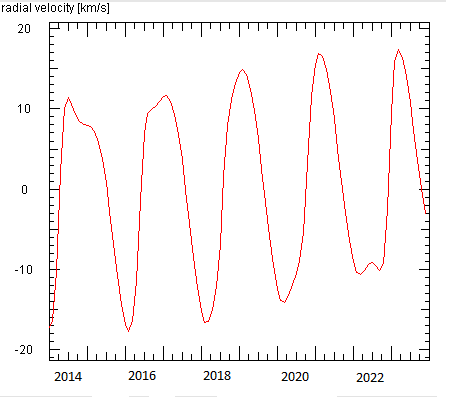
- finally, one has to take into account the motion of the spacecraft in its orbit around
Mars. This velocity is in the order of 2 km/s, which gives another 56 kHz,
again much larger than the receiver bandwidth. To do this computation, one
needs a good knowledge of the orbit or at least a good estimate!
Without the calculations for the frequency corrections the reception is simply impossible!
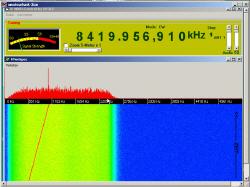
|
Mars Express on its way to Mars. During the 2 minutes of the shown recording
the frequency varies by about 500 Hz, which corresponds to a 18 m/s velocity
change. The acceleration of 0.15 m/s2 derived from this is not
the acceleration experienced by the spacecraft, but merely the change in
relative velocity, maily due to the rotation of the Earth during this observation...
|
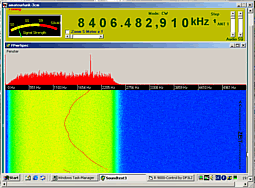
|
Mars probe Odyssey on its trajectory around Mars, at the turning point of the
Doppler shift. Since the frequency reaches a minimum value, one sees here
the point in the orbit at which the spacecraft moves radially away from us,
and thus the radial velocity reaches its maximum value.
|
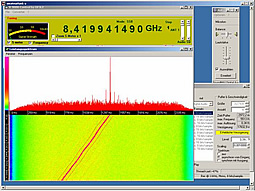
|
Signals may also look much more complicated: During transmission of data
or telemetry one can observe apart from the main carrier also subcarriers
and modulation sidebands (Mars Express)
|
From the time-dependence of the radial velocity one can draw conclusions about the
orbit. On one hand, the time between two successive reversals of the Doppler shift
gives the orbital period; on the other hand the shape of the Doppler curve allows
to infern on the form of the orbit. A circular orbit has a simple, sinusoidal
Doppler curve. A probe on a highly elliptical orbit will spend a long time near the
apocentre, and will fly through the pericentre during a very short time but with
high speed. The following simulation allows to display the influence of the
various orbital parameters on the shape of the Doppler curve.
It shows the orbit of a spacecraft orbiting the planet Mars how it
appears to an observer from Earth. The orbital parameters: minimum and maximum
(pericentric and apocentric) heights above the martian surface, orbital inclination
with respectto the martian equator, and the argument of the pericentre (which determines
the position of the pericentirc point on the orbit) can be specified by the user.
From these, orbital period and eccentricity are computed and displayed.
The observer's view of the planet is specified by the longitude and latitude of
the centre of the martian disc.
The left hand plot shows the observer's view of the orbit, the right hand
plot displays the radial velocity. The small red circle marks the starting
point of the simulation, at apocentric distance.
In the interest of reliable results extremely eccentric orbits (ε>0.9)
will not be computed.
Observations of Mars Express
Unpfortunately the insertion into martian orbit could not be observed. On 25 dec 2003 we were
very curious, what would happen to the signal and the Doppler shift. Unfortunately a fault occurred
in our system, so that measurements could only be done the following day. Mars rose on time
and Mars Express was immediately detected!
Later we started to record the received frequency. For example a recording on 10 and 11 jan 2004:
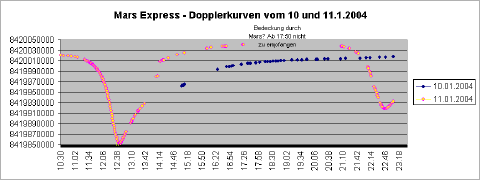
These data give an orbital period of 10:10 hrs:min. This would correspond to a
circular orbit in 4500 km altitude. Interpretation of the shape of the Doppler curve,
e.g. with the above simulation, indicates a strongly elliptical orbit, to account for
the rapidly falling and rising frequency (viz. rising and falling radial velocity).
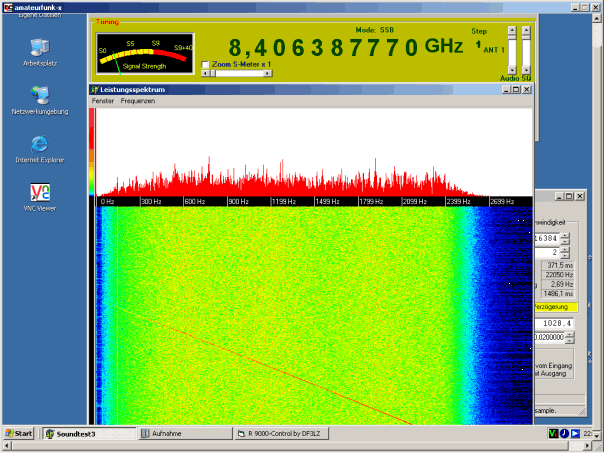
|
The spacecraft vanishes behind Mars. One sees nicely how the signal strength
decreases slowly, as it has to pass through the denser matrian atmosphere.
After 92 minutes the signal appeared again.
|
Mars Reconnaissance Orbiter
Another interesting example is this NASA probe, launched on 12 aug 2005, reached martian
orbit on 10 march 2006, and on 12 sep 2006 reached the planned almost polar, sun-synchronous
orbit in about 250 ... 316 km altitude, with a period of 112 min.
Its mission is the mapping of the planet and to act as a relay station to and from the
martian landers. On 25 dec 2009 we obtained this recording:
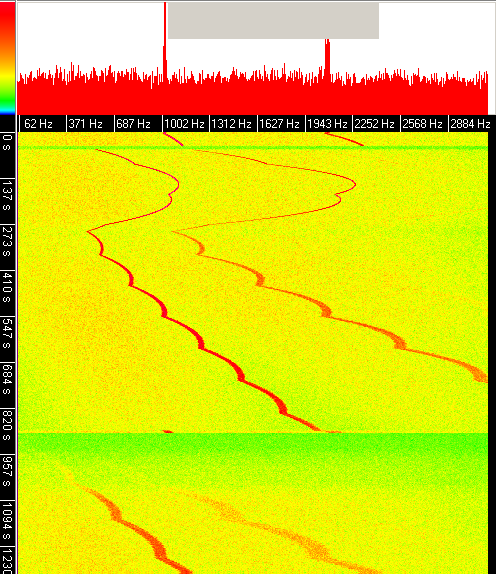
|
The signal from MRO shows regularly repeting shifts in frequency. The shift ia about
100 Hz, corresponding to a velocity of 3.5 m/s. The period of about 70 sec yields
8 cm for the distance between the antenna from the centre
of ortation (for more explanations). This motion is due to
the re-alignment of the antenna, which is done in regular intervals in order
to keep the antenna pointed to the Earth, to compensate the spacecraft's changing
attitude along the orbit.
|

